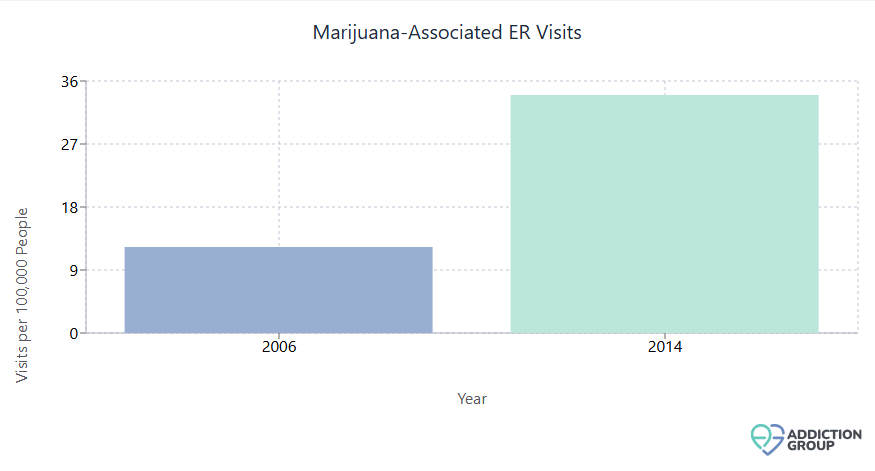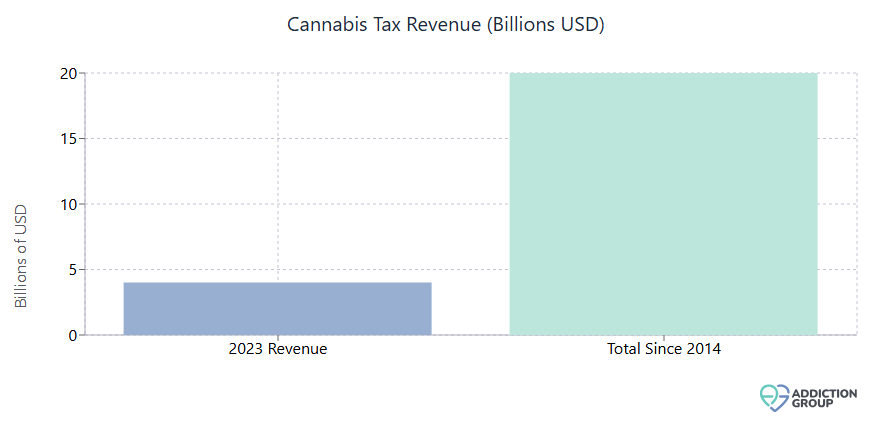National Trends and Statistics in Marijuana Use Post-Legalization


In This Article
Marijuana legalization has reshaped the landscape of substance use in the United States, prompting new research into its broader impacts. As more states adopt legalized medical or recreational cannabis, policymakers and the public are seeking reliable data to understand how legalization affects demographics, usage patterns, healthcare systems, and community well-being.
Over the past decade, studies have documented changing marijuana use trends across different age groups, shifts in consumption methods, and evolving outcomes in public health and safety. While many feared an explosion in underage use or dangerous spikes in impaired driving, national statistics paint a more nuanced picture. At the same time, concerns about heavy use and mental health effects remain significant. By examining the latest data, we gain insights into the ongoing benefits and challenges of legalized cannabis.
Noteworthy Statistics
- Daily or near-daily marijuana use (17.7 million people in 2022) has now surpassed the number of daily alcohol users in the U.S.
- Youth cannabis use has declined by nearly one-third over a 10-year span, despite legalization in multiple states.
- Emergency room visits linked to marijuana more than doubled nationwide between 2006 and 2014, with further increases through 2018.
- Tax revenue from recreational cannabis exceeded $4 billion in 2023 alone across states with legal markets.
Shifting Demographics of Cannabis Use
Understanding the age and demographic profile of cannabis consumers is key to effective policy and prevention strategies. Recent findings indicate that legalization has broadened the demographic range of those who use marijuana, affecting everything from healthcare planning to workplace policies.
- Older Adults Growing Fastest
- Past-year use among adults aged 65+ doubled in just a few years (from roughly 2.4% in 2015 to over 4% by 2018).
- Many older individuals report turning to cannabis for pain relief or sleep aid.
- Young Adults Remain Highest Users
- Adults aged 18–25 still report the highest consumption rates nationally, although the gap between young adults and other age brackets has narrowed slightly.
- In states with full legalization, some data show a modest 10% increase in monthly use among young adults - an incremental change, not a drastic shift.
- Adolescents Not Driving Overall Increases
- Contrary to early fears, legalization has not triggered an upswing in teen usage. National surveys show a measurable decline in past-month cannabis use among high schoolers over the past decade.
Increased Usage Frequency
Beyond who is using marijuana, how often people consume it has also changed. Legal, regulated access appears to correlate with a rise in frequent and heavy use - important information for public health authorities tracking potential substance use disorders.
- Surge in Daily/Near-Daily Use
- The number of Americans using cannabis every day or almost daily has grown substantially. In 2022, an estimated 17.7 million people reported daily or near-daily use - now exceeding daily alcohol consumers.
- Heavy use is notably up in older adults, who historically had much lower rates.
- Moderate Increases in Occasional Use
- Occasional (weekly/monthly) marijuana use has more than doubled since 2013, from around 7% to 15% of adults.
- This growth is driven in part by new users - often middle-aged or senior adults - experimenting under more permissive laws.
- Cannabis Use Disorder Concerns
- About one-third of regular cannabis users experience symptoms consistent with a cannabis use disorder, a proportion that has not drastically changed.
- However, because the total pool of users is larger, the absolute number of individuals with a potential disorder has increased.
Sponsored
Online Therapy Can Help
Over 3 million people use BetterHelp. Their services are:
- Professional and effective
- Affordable and convenient
- Personalized and discreet
- Easy to start
Answer a few questions to get started

Rise of Alternative Consumption Methods
Legalization has paved the way for a diverse marketplace of cannabis products. Today, consumers can choose from an extensive range of THC-infused options, which can shift patterns of use and associated risks.
- Edibles
- Cannabis-infused gummies, chocolates, and beverages have soared in popularity.
- Though edibles avoid smoke-related lung irritation, delayed onset can lead to accidental over-consumption or panic episodes.
- Vaping and Concentrates
- Cannabis vaping surged among both youth and adults in the late 2010s.
- Concentrated forms (e.g., “dabs,” wax) deliver higher THC levels rapidly, posing new challenges for public health - especially regarding acute psychotic episodes.
- Smoking Still Common but Declining Proportionally
- Many long-time users prefer traditional smoking (joints, pipes), yet its overall share of marijuana consumption has dipped as vaping and edibles rise.
- Public health officials emphasize “start low, go slow” messaging, especially for higher-potency products in the marketplace.
Sponsored
Get Professional Help
BetterHelp can connect you to an addiction and mental health counselor.
Answer a few questions to get started

Mental Health Correlations
One of the most closely examined aspects of increased marijuana use is its interaction with mental health. While cannabis might offer short-term relaxation for some, heavy or early-onset use can heighten risks for psychiatric symptoms.
- Psychosis and Schizophrenia
- Heavy cannabis use is consistently associated with elevated risk of psychotic disorders among vulnerable populations.
- Adolescents or young adults with genetic predispositions may be at higher risk; however, most users do not develop full-blown psychosis.
- Depression and Anxiety
- Long-term, heavy cannabis use can worsen or contribute to depressive episodes in a subset of individuals.
- Some studies also link chronic use to increased social anxiety, though evidence for generalized anxiety disorder is less conclusive.
- Suicidality
- Suicidal ideation and behaviors appear at somewhat higher rates among frequent cannabis users, but causation is difficult to establish.
- Mental health professionals recommend screening for heavy marijuana use during risk assessments.
Emergency Department Visits
Emergency departments (EDs) across the country have reported a significant rise in cannabis-related visits. While not all these admissions are life-threatening, they do strain resources and point to challenges in public education about safe use.
- National Surge in ER Rates
- Between 2006 and 2014, marijuana-associated ER visits more than doubled nationally, increasing from about 12.3 per 100,000 people to over 34 per 100,000.
- Subsequent analyses show continued growth through 2018 as more states legalized.
- Edible Products & Acute Psychiatric Symptoms
- A disproportionate share of ER visits stems from edibles, often linked to anxiety, panic attacks, or transient psychosis.
- Delayed onset and higher THC content may catch new users off guard.
- Cannabinoid Hyperemesis Syndrome (CHS)
- A puzzling condition characterized by recurrent vomiting in long-term heavy users, CHS has become more widely recognized.
- Some hospitals report the incidence of CHS cases doubling post-legalization.

Sponsored
Phone, Video, or Live-Chat Support
BetterHelp provides therapy in a way that works for YOU. Fill out the questionnaire, get matched, begin therapy.
Answer a few questions to get started

Impact on Treatment Patterns
One unexpected trend in the legalization era is that treatment admissions for marijuana-related problems have fallen, even as usage rates have risen. This dynamic may reflect changing attitudes, fewer court-ordered referrals, or underestimation of cannabis dependence.
- Decline in Formal Treatment Admissions
- Nationwide, the share of individuals citing marijuana as their primary substance use problem has dropped significantly over the past decade.
- In Colorado, marijuana treatment admissions declined 34% from 2013 to 2020.
- Reduced Stigma vs. Reduced Awareness
- Decriminalization and legalization have diminished the need for mandated treatment, historically a key driver of youth admissions.
- Fewer people see their cannabis use as problematic; only 6% of those meeting cannabis use disorder criteria seek help.
- Court Diversion Changes
- With possession no longer prosecuted in many jurisdictions, adolescents are no longer funneled into treatment as a legal consequence, driving down admissions.
Geographic Variation
Where people live strongly influences their likelihood of using marijuana, reflecting both cultural norms and policy landscapes. Regions with established legal markets see higher reported use, while states retaining prohibition remain lower-use areas.
- Highest-Use States
- Oregon, Colorado, and several Northeastern states (e.g., Vermont) consistently rank among the top in per capita marijuana consumption.
- In some of these states, over 30% of adults report using cannabis in the past year.
- Lowest-Use States
- Many Southern states (e.g., Mississippi, Alabama) and parts of the Midwest (e.g., Kansas) maintain low use rates, correlating with more restrictive laws and conservative social attitudes.
- Fewer than 10% of adults in those states report past-month cannabis use.
- Urban vs. Rural
- Urban centers display higher consumption rates, likely due to greater dispensary access and broader acceptance.
- Rural areas often have fewer legal outlets and sometimes stronger residual stigma.
Socioeconomic Impact (Employment and Beyond)
The intersection of marijuana use with employment policies, workplace safety, and economic opportunities is increasingly complex in a post-legalization landscape.
- Drug Testing Trends
- Workplace drug tests detect THC more often than in past years; positivity rates rose from 2.0% in 2016 to 2.7% in 2020, and continue climbing.
- Some employers have responded by removing THC from pre-employment panels to broaden their labor pool.
- Industry Growth
- The legal cannabis sector employs hundreds of thousands of workers - over 400,000 jobs nationwide by some estimates.
- Tax revenues frequently fund local job training and community programs, integrating cannabis into broader economic development.
- Safety-Sensitive Roles
- Zero-tolerance policies persist in fields like transportation and construction, where impairment poses major risks.
- Balancing off-duty legal use with occupational safety remains an ongoing challenge for regulators.
Traffic Safety
Driving under the influence of marijuana is illegal in every state, but measuring impairment can be more complex than with alcohol. Legalization’s impact on traffic incidents has prompted extensive study.
- Rise in THC-Positive Fatal Crashes
- In Colorado, the number of traffic fatalities involving a driver who tested positive for THC more than doubled from 2013 to 2020.
- THC detection, however, does not necessarily prove impairment at the time of a crash.
- Mixed Findings on Overall Accident Rates
- Some research links recreational legalization with a modest uptick in collision claims, while other studies show no significant change in total crash fatalities.
- Many impaired-driving incidents involve multiple substances (e.g., cannabis and alcohol), complicating analysis.
- Public Awareness Campaigns
- “Drive High, Get a DUI” messages and similar efforts aim to educate consumers that cannabis can impair reaction time and judgment.
- Surveys in legal states show increasing acceptance that driving after using marijuana is risky - a gradual shift in attitudes.
Healthcare Costs
Legal cannabis brings both potential savings (reductions in prescription drug spending) and additional burdens (more ER visits, cases of heavy use). Overall, the net effect on healthcare expenditures appears balanced by various countervailing factors.
- Rising Costs from ER & Hospital Visits
- Cannabis-related ED admissions for panic, psychosis, or hyperemesis add to the healthcare system’s burden.
- Treating these acute cases, particularly in states with high usage rates, carries measurable expenses.
- Substitution Effects and Savings
- Access to medical cannabis is associated with fewer prescriptions for pain, anxiety, or sleep, lowering Medicare and Medicaid spending.
- Some studies show states with medical marijuana see slower growth in employer-sponsored insurance costs, suggesting a partial offset.
- Tax Revenue Supporting Public Health
- Many states allocate a portion of cannabis tax proceeds to substance use treatment, mental health services, and youth prevention.
- These funds help mitigate healthcare costs while expanding programs for at-risk populations.
Prevention and Youth Access
Protecting youth remains a core priority in legalization frameworks. The most immediate question is whether minors have gained easier access to marijuana. Data from states with regulated markets suggest otherwise.
- Strict Enforcement of Age Limits
- Dispensary compliance rates for refusing underage sales are near 100% in states like Colorado and California.
- Unlike alcohol, where compliance can be variable, marijuana retailers face robust oversight and penalties for any violations.
- Stable or Decreasing Teen Use
- Across the U.S., youth cannabis use has not increased post-legalization; in some surveys, it has declined significantly since 2010.
- Teenagers primarily obtain marijuana through social sources (friends/family) rather than licensed stores.
- Prevention Campaign Successes
- Colorado’s multi-year youth prevention efforts correlate with reduced rates of adolescent usage.
- School programs and public awareness messaging (e.g., safe storage, not driving high) have helped maintain low underage access in legal states.
Long-Term Health Effects
As marijuana use becomes more normalized, research on the consequences of chronic use over many years is advancing. While many adults use cannabis without severe adverse outcomes, consistent evidence points to risks that scale with frequency and age of onset.
- Respiratory Issues
- Heavy smoking of cannabis can lead to chronic bronchitis and other respiratory symptoms, though the link to lung cancer remains inconclusive.
- Vaping and edibles avoid combustion but can introduce other health considerations (such as chemical additives in vape products).
- Cognitive & Mental Health Impacts
- Adolescents who use marijuana heavily may experience persistent memory and attention deficits.
- In predisposed individuals, long-term use can raise the risk of psychotic disorders, with earlier onset of symptoms.
- Cannabis Use Disorder & Dependency
- Roughly one in three people who use cannabis regularly may develop some level of dependence, including withdrawal symptoms upon quitting.
- Cannabinoid Hyperemesis Syndrome also illustrates how certain health impacts emerge only after years of frequent use.
Evaluating Policy Goals
Has legalization achieved its intended outcomes? By tracking crime rates, tax revenues, youth use, and health indicators, policymakers gauge whether the new legal framework is beneficial overall or in need of adjustment.
- Substantial Drop in Cannabis-Related Arrests
- Legalization has cut marijuana possession arrests by over 70% in some states, reducing criminal justice system burdens.
- Racial disparities persist, prompting calls for further reforms such as record expungements and social equity licensing.
- Robust Tax Revenues & Economic Gains
- Since 2014, legal states collectively have generated more than $20 billion in cannabis tax receipts, funding schools, community programs, and healthcare.
- The regulated market also creates new business opportunities and employment, though the illicit market remains stubborn in certain regions with high taxes or inadequate retail access.
- Public Health Metrics
- Youth usage has not increased, a key success.
- Potential negatives - rising heavy use, more ER visits - are partly offset by medical cost savings and educational programs funded by marijuana tax dollars.

In many respects, states that have adopted legal marijuana confirm that concerns of runaway youth consumption or dramatic spikes in violent crime have not materialized. Steady declines in teen use rates and high retail compliance underscore how regulation can restrict direct access to minors. Simultaneously, economic benefits - from new tax revenue to robust job creation - have helped broaden public acceptance of legal cannabis.
Still, the data highlight areas needing attention. The growing prevalence of heavy or near-daily use raises mental health and addiction concerns, particularly among younger adults. Emergency department visits, driven by potent products like concentrates and edibles, place stress on healthcare providers. Addressing these issues through ongoing research, public education, and targeted prevention efforts remains essential as legalization continues to evolve and expand nationwide.
Finally, policymakers are refining regulatory structures to tackle challenges such as impaired driving and persistent illicit sales where legal access is uneven. While marijuana legalization is not a cure-all - nor the dire social threat some feared - the evidence suggests that, with careful regulation and public health interventions, its overall social costs can be managed. The key moving forward is vigilance: ongoing data collection, nimble policy adjustments, and unwavering commitment to safeguarding both individual well-being and community interests.
What's Next?
Sponsored
Get matched with an affordable mental health counselor
Find a TherapistAnswer a few questions to get started

Related Articles

Addiction Statistics in Australia

Statistics on the Impact of Substance Abuse on Crime Rates

Statistics on Social Media Addiction

Gender Differences in Substance Abuse and Addiction: Statistics

Tobacco Use and Vaping in the US: Statistics, Trends, and Health Implications

Statistics on Drug Addiction Treatment and Recovery Rates in the US
- American Academy of Family Physicians (AAFP) – https://www.aafp.org/news/health-of-the-public/20200304cannabisuse.html
- Centers for Disease Control and Prevention (CDC) – https://www.cdc.gov/cannabis/data-research/facts-stats/index.html
- Gallup – https://news.gallup.com/poll/284135/percentage-americans-smoke-marijuana.aspx
- Hazelden Betty Ford Foundation – https://www.hazeldenbettyford.org/research-studies/addiction-research/cannabis-use-trends
- JAMA Pediatrics – https://www.ncbi.nlm.nih.gov/pmc/articles/PMC9855298/
- Marijuana Policy Project (MPP) – https://www.mpp.org/issues/legalization/cannabis-tax-revenue-states-regulate-cannabis-adult-use/
- National Academies of Sciences, Engineering, and Medicine (NASEM) – https://www.ncbi.nlm.nih.gov/books/NBK425748/
- NORML – https://norml.org/blog/2023/10/20/colorado-compliance-check-data-confirms-that-retailers-arent-selling-marijuana-to-minors/
- Palamar et al. (Quarterly Trends in Past-Month Cannabis Use) – https://www.ncbi.nlm.nih.gov/pmc/articles/PMC7855903/
- Rocky Mountain High Intensity Drug Trafficking Area (RMHIDTA) – https://www.ncbi.nlm.nih.gov/pmc/articles/PMC8672945/
- University of Colorado Boulder – https://www.colorado.edu/today/2022/11/04/decade-after-legalizing-cannabis-colorado-heres-what-weve-learned

